Related Research Articles

Kauravi, also known as Khaṛībolī, is a Western Hindi dialect descended from Shauraseni Prakrit that is mainly spoken in Northwestern Uttar Pradesh.
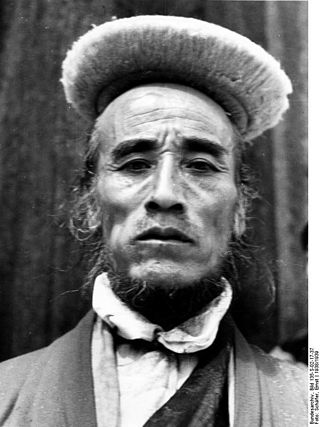
Bhotiya or Bhot is an Indian and Nepali exonym lumping together various ethnic groups speaking Tibetic languages, as well as some groups speaking other Tibeto-Burman languages living in the Transhimalayan region that divides India from Tibet. The word Bhotiya comes from the classical Tibetan name for Tibet, བོད, bod. The Bhotiya speak numerous languages including Ladakhi. The Indian recognition of such language is Bhoti / Bhotia having Tibetan scripts and it lies in the Parliament of India to become one of the official languages through Eighth Schedule of the Indian Constitution.
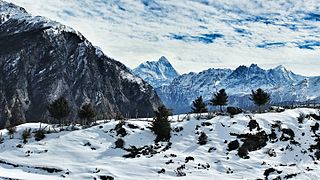
Uttarakhand, formerly known as Uttaranchal, is a state in northern India. The state is divided into two divisions, Garhwal and Kumaon, with a total of 13 districts. The winter capital and largest city of the state is Dehradun, which is also a railhead. On 5 March 2020, Bhararisain, a town in the Gairsain Tehsil of the Chamoli district, was declared as the summer capital of Uttarakhand. The High Court of the state is located in Nainital, but is to be moved to Haldwani in future.
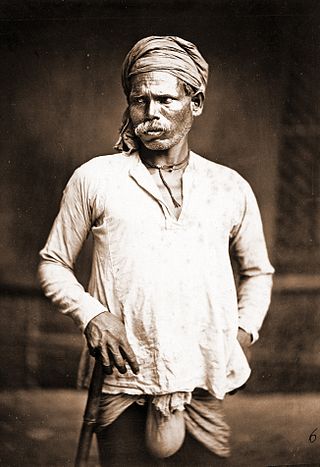
The Dom, also known as Domra, Domba, Domaka, Dombara and Dombari, are castes, or groups, scattered across India. Dom were a caste of drummer. According to Tantra scriptures, the Dom were engaged in the occupations of singing and playing music. Historically, they were considered an untouchable caste called the Dalits and their traditional occupation was the disposal and cremation of dead bodies. They are in the list of Scheduled caste for Reservation in India in the Indian states of Uttar Pradesh, Bihar, Odisha, Andhra Pradesh, Jharkhand and West Bengal.

Haldwani is the largest city of Kumaon. It is also the third most populous city and largest commercial market in the Indian state of Uttarakhand. Haldwani is said to be the financial capital of Uttarakhand, having the most commercial, economic and industrial activities of the state. Haldwani is located in the Nainital District, and is one of its eight Subdivisions. The Haldwani Urban agglomeration has 232,060 people as of 2011, and is the third most populous UA in Uttarakhand, after Dehradun and Haridwar. Being situated in the immediate foothills of Kumaon Himalayas, the Kathgodam neighbourhood of Haldwani is known as the "Gateway to Kumaon".

Udham Singh Nagar District is a district of Uttarakhand state in northern India. Rudrapur is the district headquarters. This district consists of nine Tehsils named Bajpur, Gadarpur, Rudrapur, Jaspur, Kashipur, Kichha, Khatima, Sitarganj, Nanakmatta. The district is located in the Terai region, and is part of Kumaon Division. It is bounded on the north by Nainital District, on the northeast by Champawat District, on the east by Nepal, and on the south and west by Bareilly, Rampur, Moradabad, Pilibhit and Bijnor District of Uttar Pradesh state. The district was created on 29 September 1995, by Mayawati government out of Nainital District. It is named for freedom fighter and Indian revolutionary Udham Singh.

The Baiga are an ethnic group found in central India primarily in the state of Madhya Pradesh, and in smaller numbers in the surrounding states of Uttar Pradesh, Chhattisgarh and Jharkhand. The largest number of Baiga is found in Baiga-chuk in Mandla district and Balaghat district of Madhya Pradesh. They have sub-castes: Bijhwar, Narotia, Bharotiya, Nahar, Rai maina and Kath maina. The name Baiga means "sorcerer-medicine man".

Bijnor district is one of the 75 districts in the state of Uttar Pradesh in India. Bijnor city is the district headquarters. The government of Uttar Pradesh seeks its inclusion in National Capital Region (NCR) due to its close proximity to NCT of Delhi.

Nainital district is a district in Kumaon division which is a part of Uttarakhand state in India. The headquarters is at Nainital.

Chamar is a Dalit community classified as a Scheduled Caste under modern India's system of affirmative action. They are found throughout the Indian subcontinent, mainly in the northern states of India and in Pakistan and Nepal.
Chandpur is a town and a municipal board in Bijnor district in the Indian state of Uttar Pradesh, India.
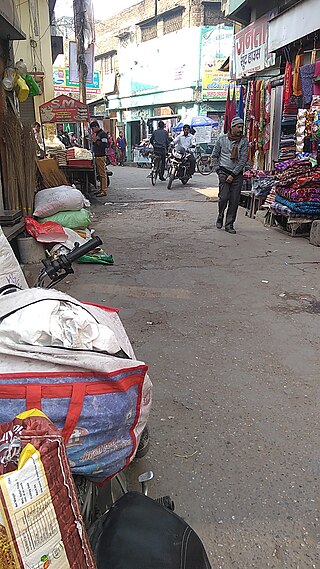
Jaspur is a developing town and a municipal board in Udham Singh Nagar district in the Indian state of Uttarakhand.
Noorpur is a City and a Municipal Board in Bijnor District in the Indian State of Uttar Pradesh.
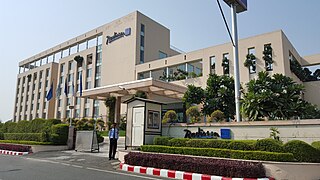
Rudrapur is a city that serves as the headquarters of the Udham Singh Nagar district in the Indian state of Uttarakhand. Located at a distance of about 250 km (160 mi) northeast of New Delhi and 250 km (160 mi) south of Dehradun, Rudrapur is located in the fertile Terai plains in the southern part of Kumaon division over an area of 27.65 km2. With a population of 140,857 according to the 2011 census of India, it is the 5th most populous city of Uttarakhand.
The demographics of Uttar Pradesh is a complex topic, which is undergoing dynamic change. Uttar Pradesh is India's most populous state, and the largest subdivision in the world. It has a population of about 199,812,341 as per the 2011 census. If it were a separate country, Uttar Pradesh would be the world's fifth most populous nation, next only to China, India, the United States of America and Indonesia. Uttar Pradesh has a population more than that of Pakistan. There is an average population density of 828 persons per km² i.e. 2,146 per sq mi. The capital of Uttar Pradesh is Lucknow, and Prayagraj serves as the state’s judicial capital. Hindus and Muslims both consider the state as a holy place.

The Tharu or Tharuhat languages are any of the Indo-Aryan languages spoken by the Tharu people of the Terai region in Nepal, and neighboring regions of Uttarakhand, Uttar Pradesh and Bihar in India.
Buksa, also known as Buksari and Bhoksa, is an Indo-Aryan language spoken by the Buksa people in parts of Uttarakhand and Uttar Pradesh, India.
The Jad people are a semi nomadic tribe living in great Himalayas in Himachal Pradesh and Uttarakhand states of India. They are primarily settled in the bordering region of Uttarakhand, Himachal Pradesh and Tibet. They mainly practiced sheep rearing and were shrewd traders trading with the Tibet. They were also recognised as the rulers of the Gartang Garh. The famous tourist destination Gartang Gali is also found near their village. They were entrusted by the King of Garhwal, with the important strategic task of securing the borders of Garhwal Kingdom from the Bushahr kingdom of Himachal and the Tibetan Empire. The language they speak is critically endangered almost endemic to India. Although, the language share some similarity to the kinnauri and spiti language which also Is of Tibeto-Burman family.
Kori is an Indian caste, who were traditionally weavers. They are descendants of Saint Kabir Das Ji Maharaj. Other names for this caste include Kamal, Kamalvansi and Shankhawar, Kabirpanthi and Julaha

Rana Tharu is an ethnic group generally classified as part of the Tharu people of Nepal and India. They are living in Kailali and Kanchanpur Districts of the far western Nepali Terai and also in India, in Udham Singh Nagar district, Uttarakhand and Kheri district of Uttar Pradesh. As of 2001, Rana Tharu people were the largest of five scheduled tribes in Uttarakhand, with a population of 256,129 accounting for 33.4% of all scheduled tribes.
References
- ↑ "Uttaranchal, Data Highlights: The Scheduled Tribes, Census of India 2001" (PDF). Retrieved 16 March 2008.
- ↑ "Uttar Pradesh, Data Highlights: The Scheduled Tribes, Census of India 2001" (PDF). Retrieved 16 March 2008.
- ↑ "Buksa". ethnologue.com. Retrieved 31 August 2012.
- ↑ "List of Scheduled Tribes". Census of India: Government of India. 7 March 2007. Archived from the original on 5 June 2010. Retrieved 27 November 2012.
- ↑ "State wise Scheduled Tribes — Uttar Pradesh" (PDF). Ministry of Tribal Affairs, Government of India. Archived from the original (PDF) on 23 November 2016. Retrieved 4 February 2017.